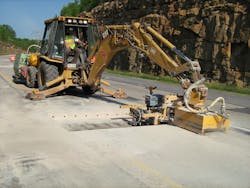Crews swift and efficient with patchwork on I-80
I-80 is the second-largest interstate highway in the country, spanning from San Francisco to Teaneck, N.J. In the spring of 2007, a concrete-patching job was under way and covered more than 20 miles of a particularly dangerous stretch from Dubois to Clearfield, Pa. The road was damaged and cracked on all four of the interstate’s existing lanes. Additionally, it was one of the only interstates in the country still lacking strength- and safety-enhancing welded wire reinforcement (WWR).
The project was awarded to the Glenn O. Hawbaker company, a local construction company based in State College, Pa. Project foreman, and Hawbaker employee for more than 20 years, Gerry Thomas estimated the crew would replace up to 60 patches per day. Each patch required 12 holes to be drilled 10 in. deep into the east- and west-facing sides for placement of dowel bars – equaling 24 holes per patch. Factor in the daily patch count of 60, and it added up to more than 1,400 holes being drilled every day.
To ensure the drilling process would go as efficiently as possible, Thomas put veteran drill operator Kerry Aikeley on the job. Aikeley was confident the best equipment choice for the project was the 210-3 EQ MT model from E-Z Drill. The backhoe-mounted, 3-gang horizontal drill offers a “side shift” feature that can drill three holes, then simply shift over to create three more holes without having to reposition the backhoe itself.
As with most road construction jobs, the deadline was a primary factor. But more than that, safety was a major concern. There was no concrete barrier or other safety measures in place to protect workers from the daily interstate traffic. This is a major reason why the crew was driven to stay on track and finish by the fall of 2010.
